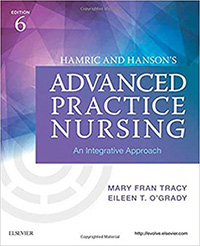
Hamric and Hanson's Advanced Practice Nursing: An Integrative Approach, 6th Edition
Authors: Mary Fran Tracy, PhD, RN, APRN, CNS, FCNS, FAAN (Ed) and Eileen T. O’Grady, PhD, RN, NP
Published: January, 2018; Elsevier
Edited and written by a Who’s Who of internationally known advanced practice nursing experts, Hamric and Hanson's Advanced Practice Nursing: An Integrative Approach, 6th Edition helps you develop an understanding of the various advanced practice registered nursing (APRN) roles. This bestselling textbook provides a clear, comprehensive, and contemporary introduction to advanced practice nursing today, addressing all major APRN competencies, roles, and issues. It covers topics ranging from the evolution of advanced practice nursing to evidence-based practice, leadership, ethical decision-making, and health policy. New to this edition is expanded coverage of interprofessional collaborative practice, updated coverage of APRN roles related to implementation of healthcare reform in the U.S., updated and expanded coverage of IOM and QSEN, a global focus on international advanced practice nursing, and much more!
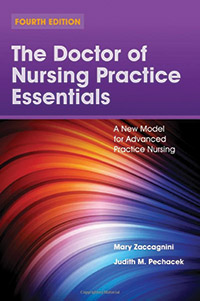
The Doctor of Nursing Practice Essentials: A New Model for Advanced Practice Nursing
Fourth edition, edited by Clinical Associate Professor Judith Pechacek, DNP, RN, CENP, and Clinical Assistant Professor ad Honorem Mary Zaccagnini, DNP, APRN, ACNS-BC, was published by Jones & Bartlett Learning. Faculty and alumni contributors include Sandra Edwardson, Stephanie Breckenridge, Sarah Held, Amberly Hess, Roberta Huna Wagner, Katelyn Erickson, Anne LaFlamme, Jeanne Pfeiffer, Deborah Ringdahl, Melissa Saftner, Denise Felsenstein and Carol Flaten.
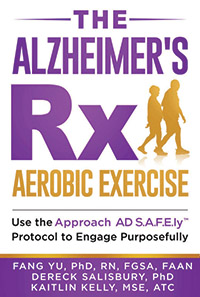
The Alzheimer's Rx: Aerobic Exercise: Use the Approach AD S.A.F.E.ly™ Protocol to Engage Purposefully
Written by Professor Fang Yu, PhD, RN, GNP-BS, FAAN, Assistant Professor Dereck Salisbury, PhD, and Exercise Interventionist Kaitlin Kelly, MSE, ATC, was published.
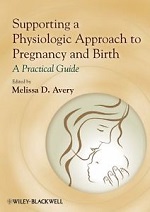
Supporting a Physiologic Approach to Pregnancy and Birth: A Practical Guide
Editor: Melissa D. Avery, PhD, RN, CNM, FACNM, FAAN
Published: June 2013, Wiley-Blackwell
Supporting a Physiologic Approach to Pregnancy and Birth: A Practical Guide provides an overview of current evidence and a range of practical suggestions to promote physiologic birth within the United States healthcare system. Presenting the latest evidence available on practical approaches and minimal interventions, this book looks into clinic exam rooms and hospital labor units to investigate the possibilities for improving the pregnancy and labor experience. Contributors discuss recent research and other published information and present a range of ideas, tools, and solutions for maternity care clinicians, including midwives, nurses, physicians, and other members of the perinatal team.
An invaluable resource, Supporting a Physiologic Approach to Pregnancy and Birth is a must-have practical guide for those involved in all aspects of pregnancy and birth.
Editor Bio: Melissa D. Avery, PhD, CNM, FACNM, FAAN is Professor, Chair of the Child and Family Health Cooperative Unit, and directs the midwifery program at the University of Minnesota’s School of Nursing. She is the past president of the American College of Nursing Midwives. Dr. Avery has authored numerous articles and is nationally known for her research in midwifery and women’s health.
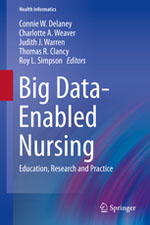
Big Data-Enabled Nursing
Editors: Connie White Delaney, PhD, RN, FAAN, FACMI , Weaver, C.A., Warren, J.J., Thomas R. Clancy, PhD, MBA, RN, FAAN , Simpson, R.L. (Eds.)
Published: 2017
Historically, nursing, in all of its missions of research/scholarship, education and practice, has not had access to large patient databases. Nursing consequently adopted qualitative methodologies with small sample sizes, clinical trials and lab research. Historically, large data methods were limited to traditional biostatical analyses. In the United States, large payer data has been amassed and structures/organizations have been created to welcome scientists to explore these large data to advance knowledge discovery. Health systems electronic health records (EHRs) have now matured to generate massive databases with longitudinal trending. This text reflects how the learning health system infrastructure is maturing, and being advanced by health information exchanges (HIEs) with multiple organizations blending their data, or enabling distributed computing. It educates the readers on the evolution of knowledge discovery methods that span qualitative as well as quantitative data mining, including the expanse of data visualization capacities, are enabling sophisticated discovery. New opportunities for nursing and call for new skills in research methodologies are being further enabled by new partnerships spanning all sectors.
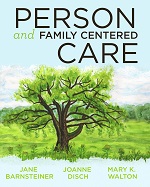
Person and Family Centered Care
Author: Joanne Disch, PhD, RN, FAAN
Published: May 2014, Sigma Theta Tau International
Person and Family Centered Care offers a new approach that begins with the person, embraces the family, and encompasses all care delivery locations. At the forefront of this movement are authors Jane Barnsteiner, Joanne Disch, and Mary K. Walton, who present a surprisingly practical clinical reference covering a vast array of patient-care scenarios, together with effective strategies for achieving optimal outcomes. This groundbreaking text is a complete resource that ensures the needs of patients, families, and caregivers are met.
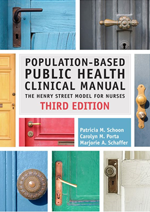
Population-Based Public Nursing Clinical Manual 3rd Edition: The Henry Street Model for Nurses
Authors: Carolyn M. Porta, PhD, MPH, RN, PHN, SANE-A, FAAN, Marjorie A. Shaffer, PhD, MS, RN, PHN, Patricia M. Schoon, DNP, MPH, RN, PHN
Published: 2018, Sigma Theta Tau International
Population-Based Public Health Clinical Manual: The Henry Street Model for Nurse has proven to be one of the most important public health texts for students and practitioners alike. Focused on developing evidence-based public health nursing practice in diverse settings, the core text builds on the Henry Street Consortium’s framework of 12 competencies for population-based, enter-level public health nursing (PHN). This full-color, newly designed third edition has completely revised and updated coverage, including:
- A new competency on utilizing principles and science of environmental health to promote safe and sustainable environments for individuals, families, systems, and communities
- Examples demonstrating the global growth in public health nursing
- Theory applications showing how PHNs use frameworks to further public health initiatives
- United Nations Sustainable Development Goals (SGDs) providing a framework for public health nursing practice
Author Bios:
Patricia M. Schoon, DNP, MPH, RN, PHN, is Assistant Professor at Metropolitan State University. She is a founding member of the Henry Street Consortium.
Carolyn M. Porta, PhD, MPH, RN, PHN, SANE-A, FAAN, is Professor and Director of Global Health in the School of Nursing and adjunct faculty in the School of Public Health at the University of Minnesota.
Marjorie A. Shaffer, PhD, MS, RN, PHN, is Professor of Nursing Emerita at Bethel University. She is a founding member of the Henry Street Consortium.
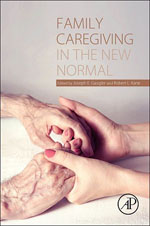
Family Caregiving in the New Normal
Authors: Joseph E. Gaugler, PhD, Robert L. Kane, MD
Published: May 11 2015, Academic Press
Family Caregiving in the New Normal discusses how the drastic economic changes that have occurred over the past few years have precipitated a new conversation on how family care for older adults will evolve in the future.
This text summarizes the challenges and potential solutions scientists, policy makers, and clinical providers must address as they grapple with these changes, with a primary focus given to the elements that may impact how family caregiving is organized and addressed in subsequent decades, including sociodemographic trends like divorce, increased participation of women in the workforce, geographic mobility, fewer children in post-baby boom families, chronic illness trends, economic stressors, and the current policy environment.
A section on the support of caregivers includes technology-based solutions that examine existing models, personal health records, and mobile applications, big data issues, decision-making support, person-centered approaches, crowd-sourced caregiving such as blogs and personal websites that have galvanized caregivers, and new methods to combine paid and unpaid forms of care.
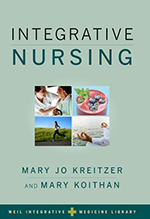
Integrative Nursing
Authors: Mary Jo Kreitzer, PhD, RN, FAAN, Mary Koithan, PhD, RN, APRN, CNS;
Published: February 17, 2014, Oxford University Press
Integrative medicine is defined as healing-oriented medicine that takes account of the whole person (body, mind, and spirit) as well as all aspects of lifestyle. It emphasizes the therapeutic relationship and makes use of appropriate therapies, both conventional and alternative.
This volume is the first complete roadmap to integrative nursing, providing a step-by-step guide to assess and clinically treat conditions through a variety of combined methodologies including wellness, lifestyle enhancement, and nutrition. this text puts forth both the skills and theoretical frameworks for multidisciplinary leaders to consider and implement integrative healthcare strategies within institutions, including several case studies involving practical nursing-led initiatives.
Sections one and two cover the foundations, including principles and best practices, healing environments, whole systems healing, and measurement of outcomes. the third section outlines major areas of system management such as pain, nausea, insomnia, anxiety, depression, stress, and behavioral dysfunction. the fourth and fifth sections address applications to patient populations, models of care, and models of education. the final section collects global perspectives. the academic rigor of the text is balanced by practical and relevant content that can be readily implemented into practice for both established professionals as well as students enrolled in undergraduate or graduate nursing programs.

Complementary & Alternative Therapies in Nursing
Authors: Ruth Lindquist, PhD, RN, APRN-BC, FAAN (Editor), Mariah Snyder, PhD (Editor), Mary Frances Tracy, PhD, RN, CCNS, FAAN (Editor)
Published: March 2018, Springer Publishing Company
Now in its eighth edition, this highly acclaimed, newly revised and expanded text continues to deliver innovative practice guidelines for evidence-based complementary and alternative therapies that can easily be incorporated into curriculum and applied directly to practice. The book describes holistic treatments that are culturally appropriate for clients across the life span and NCLEX®-relevant content appropriate for preparation of advanced practice nurses.
The eighth edition reflects an expanding interest in these therapies worldwide and features numerous sidebars by international contributors who provide a global perspective that builds readers’ understanding of the cultural derivations and uses of complementary therapies. The new edition also highlights digital and technical advances, provides key updates to foundations for practice, and describes cutting-edge research. Included is a description of the evolution and establishment of the National Center for Complementary and Integrative Health (NCCIH) and its current national agenda. Updated legal information regarding regulation and credentialing, enlarged safety and precaution content, and the inclusion of a broad range of therapies add to the utility of this new edition.
The only book about complementary and alternative therapies written specifically for nurses that focuses on essential evidence for practice, the text uses a consistent format to present a definition and description of each therapy, a summary of how it evolved, and a rationale for its use. The scientific basis and research evidence for use of each therapy in a variety of specific patient populations is emphasized. Sidebars in each chapter describe the use of various therapies in different settings worldwide. All chapters provide practical guidelines for using the therapies to promote health and comfort while increasing patients’ well-being and satisfaction with care.
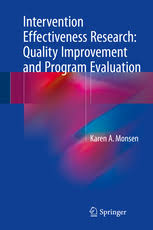
Intervention Effectiveness Research: Quality Improvement and Program Evaluation
Author: Karen A. Monsen, PhD, RN, FAAN
Published: 2018
Do interventions improve health outcomes? This volume provides a model and road map to answer clinical questions related to intervention effectiveness research, quality improvement, and program evaluations. It offers clear and simple guidance for all phases of a clinical inquiry projects from planning through dissemination and communication of results and findings. The book emphasizes the value and importance of leveraging existing data to advance research, practice, and quality improvement efforts.
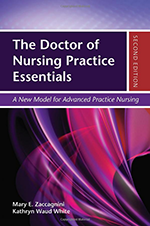
The Doctor of Nursing Practice Essentials: A New Model for Advanced Practice Nursing
Authors: Kathryn W. White, DNP, RN, CRNA, Mary Zaccagnini, DNP, RN, CNS
Published: February 7, 2013
The newly revised Second Edition of The Doctor of Nursing Practice Essentials: A New Model for Advanced Practice Nursing is the first text of its kind and is modeled after the eight DNP Essentials as outlined by the American Association of Colleges of Nursing (AACN). Each section discusses the materials relevant to an element of the Essentials document and advises on the steps necessary to fulfill the requirements of the degree. The text is written for current DNP students as well as those considering the degree program. It also serves as a fantastic reference for professionals and those who have already completed a DNP program.
Author Bios:
Kathryn White, DNP, RN, CRNA-University of Minnesota, School of Nursing, Minneapolis, Minnesota
Mary Zaccagnini, DNP, RN, ACNS-BC-Faculty Ad Honorarium, University of Minnesota, School of Nursing, Minneapolis, Minnesota
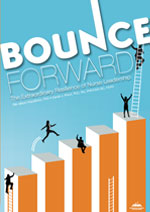
Bounce Forward: The Extraordinary Resilience of Nurse Leadership
Authors: Dan Pesut, PhD, RN, FAAN and Elle Allison-Napolitano, PhD
Published: March 2015, Nursesbooks.org
Dan Pesut co-authored “Bounce Forward: The Extraordinary Resilience of Nurse Leadership” with Elle Allison-Napolitano. The book uses real-life stories to provide nurses in all practice settings with a model and methods to cultivate the personal, professional and organizational resilience they need to achieve nursing’s vision of a transformed 21st-century health care system.
The book is broken into four sections, each illuminating the concept of leadership resilience, what it takes to become a resilient leader, how to put your leadership resilience into action and how to foster resilient organizations.
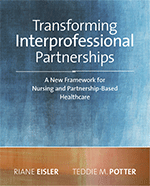
Transforming Interprofessional Partnerships: A New Framework for Nursing and Partnership-based Health Care
Authors: Riane Eisler, JD, Hon. PhD; Teddie M. Potter, PhD, RN
Published: January 10, 2014
This is the only text written exclusively from the nursing perspective, providing important aspects of patient partnership with other professional disciplines. It is designed to shift the paradigm for relationships in health care. These relationships include nurse-patient, nurse-nurse, nurse-primary provider, nurse-health care team, nurse-health care system, nurse-environment, and nurse-community/society. Shifting the paradigm will move nurses from a place of passivity to a place of informed leadership. It will allow nurses to expand their thinking from powerlessness to people of influence, shaping effective and efficient health systems. This text will teach nurses how to create hierarchies of actualization for patients, health care organizations, and communities.
Author Bios:
Riane Eisler, JD, Hon.PhD is the President of the Center for Partnership Studies. Dr. Eisler, social theorist, attorney, and author is best known for her internationally acclaimed book, The Chalice and the Blade: Our History, Our Future (1987). Dr. Eisler has written over 300 articles and has received numerous awards including the Nuclear Age Peace Foundation’s 2009 Distinguished Peace Leadership Award.
Teddie Potter, PhD, RN is a Clinical Associate Professor and the Coordinator of Doctor of Nursing Practice in Health Innovation and Leadership at University of Minnesota, School of Nursing. Dr. Potter was one of the first scholars to apply Riane Eisler’s work to the nursing profession.